Homage to Fromage - Stilton
By Louis Luzzo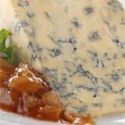
Long known as “The King of Cheeses,” blue Stilton is one of a handful of British cheeses granted the status of a “protected designation origin” (PDO) by the European Commission. Only cheese produced in the three counties of Derbyshire, Leicestershire and Nottinghamshire and made according to a strict code may be called Stilton. There are just six dairies licensed to make Stilton.
To be called Stilton, each cheese must:
•Be made only in the three counties from local milk which is pasteurized before use
•Be made only in a traditional cylindrical shape
•Be allowed to form its own crust or coat
•Be un-pressed
•Have delicate blue veins radiating from the center
•Have a taste profile typical of Stilton
How did it get its name?
Stilton is still made in much the same way as it was when Daniel Defoe, writing in his “Tour through England & Wales” in 1727, remarked that he “...passed through Stilton, a town famous for cheese." And yet, Stilton was never made in the town of Stilton!Go to fullsize image
 Stilton is situated about 80 miles north of London on the old Great North Road. In the 18th century, the town was a staging post for coaches travelling from London to York. Horses would be changed and travellers served light refreshments at one of the hostelries in the town. Cooper
Stilton is situated about 80 miles north of London on the old Great North Road. In the 18th century, the town was a staging post for coaches travelling from London to York. Horses would be changed and travellers served light refreshments at one of the hostelries in the town. Cooper  Thornhill, an East Midlands entrepreneur, was landlord at the famous Bell Inn and it was he who introduced these travellers to a soft, creamy, blue veined cheese which subsequently took its name from the town. Thornhill had brought the cheese from a farmer’s wife by the name of Frances Pawlett who lived near Melton Mowbray. The rest, they say, is history!
Thornhill, an East Midlands entrepreneur, was landlord at the famous Bell Inn and it was he who introduced these travellers to a soft, creamy, blue veined cheese which subsequently took its name from the town. Thornhill had brought the cheese from a farmer’s wife by the name of Frances Pawlett who lived near Melton Mowbray. The rest, they say, is history!
How is Stilton made?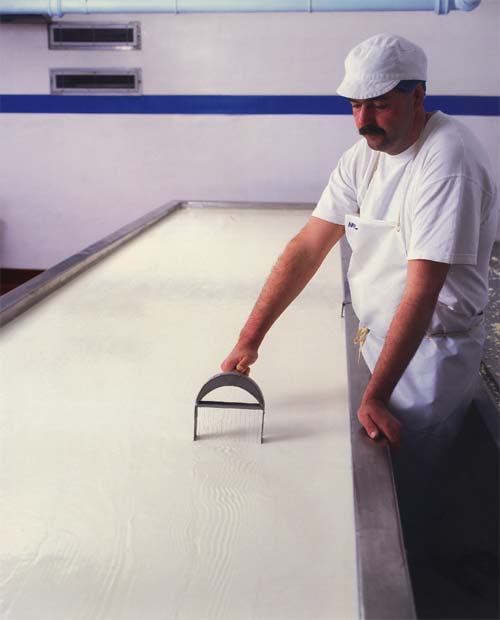
Early each morning fresh pasteurized milk is fed into an open vat to which acid forming bacteria (starter cultures), a milk clotting agent (such as rennet) and “penicillium roqueforti” (blue mould spores) are added. Once the curds have formed, the whey is removed and the curds allowed to drain overnight.
The following morning, the curd is then cut into blocks to allow further drainage before being milled and salted. 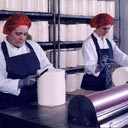 Each cheese requires about 24 lb of salted curd that is fed into cylindrical moulds. The moulds are then placed on boards and turned daily to allow natural drainage for 5 or 6 days. This ensures an even distribution of moisture throughout the cheese so that, as the cheese is never pressed, it creates the flaky, open texture required for the important blueing stage.
Each cheese requires about 24 lb of salted curd that is fed into cylindrical moulds. The moulds are then placed on boards and turned daily to allow natural drainage for 5 or 6 days. This ensures an even distribution of moisture throughout the cheese so that, as the cheese is never pressed, it creates the flaky, open texture required for the important blueing stage.
After 5 or 6 days, the cylinders are removed and the coat of each cheese is sealed by smoothing or wrapping to prevent any air entering the inside of the cheese. 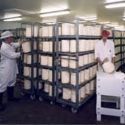 The cheese is then transferred to the store where temperature and humidity are carefully controlled. Each cheese is turned regularly during this ripening period. At about 6 weeks, the cheese is forming the traditional Stilton crust and it is then ready for piercing with stainless steel needles. This allows air to enter the body of the cheese and create the magical blue veins associated with Stilton.
The cheese is then transferred to the store where temperature and humidity are carefully controlled. Each cheese is turned regularly during this ripening period. At about 6 weeks, the cheese is forming the traditional Stilton crust and it is then ready for piercing with stainless steel needles. This allows air to enter the body of the cheese and create the magical blue veins associated with Stilton.
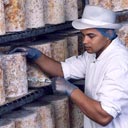 At about 9 weeks of age, by which time each cheese now weighs about 17 lbs, the cheese is ready to be sold. But before this happens every cheese must be graded using a cheese iron. The iron is used to bore into the cheese and extract a plug of cheese. By visual inspection and by smell the grader can determine whether the cheese is up to the mark and able to be sold as Stilton. Cheese that is not up to the mark will be sold as “blue cheese.”
At about 9 weeks of age, by which time each cheese now weighs about 17 lbs, the cheese is ready to be sold. But before this happens every cheese must be graded using a cheese iron. The iron is used to bore into the cheese and extract a plug of cheese. By visual inspection and by smell the grader can determine whether the cheese is up to the mark and able to be sold as Stilton. Cheese that is not up to the mark will be sold as “blue cheese.”
 At this age, Stilton is still quite crumbly and has a slightly acidic taste. Some customers prefer a more mature cheese and after a further 5 or 6 weeks it will have a smoother, almost buttery texture, with a more rounded mellow flavor.
At this age, Stilton is still quite crumbly and has a slightly acidic taste. Some customers prefer a more mature cheese and after a further 5 or 6 weeks it will have a smoother, almost buttery texture, with a more rounded mellow flavor.
The Stilton Cheesemakers' Association (SCMA)
The SCMA was formed in 1936 to represent the interests of the Stilton manufacturers and to raise standards. Today the SCMA has those same objectives but is also responsible for:
•Promoting Stilton world-wide
•Managing the trade marks; and
•Ensuring that standards are maintained at all licensed dairies.
Stilton Cheese Makers AssociationThe SCMA was granted a certification trademark for Stilton in 1966 and is still the only British cheese so accredited. This meant that the good name of Stilton was protected and that imitations produced other than in the three counties of Derbyshire, Leicestershire, and Nottinghamshire could not be sold under the Stilton brand.
In 1996, the SCMA succeeded in achieving “Protected Designation of origin” status for Blue Stilton from the European Commission. Whereas certification trademarks had to be separately applied for in each EU country, the PDO effectively gave Stilton protection from imitation across the whole of the EU.
The SCMA is responsible with the relevant government authorities for ensuring correct use of the Stilton name and in recent years action been taken against traders, manufacturers and retailers in the UK and elsewhere who have attempted to pass off ineligible cheese as Stilton.
Facts and Figures
•There are just 7 dairies in the world licensed to make Blue Stilton cheese
•Stilton is a “protected name” cheese and by law can only be made in the three counties of Derbyshire, Leicestershire, Nottinghamshire
•It takes 136 pints milk to make one 17 lb Stilton cheese
•Stilton takes its name from the village of the same name in Cambridgeshire although the cheese has never been made there
•Over 1 million Stilton cheeses are made each year
•More than 10% of output is exported to some 40 countries world-wide
•Every cheese is graded before leaving the dairy to ensure only cheese of the highest quality is marketed under the Stilton nameWhite Stilton is also a protected name cheese and is made in a similar way to its blue cousin - except that no mould spores are added and the cheese would be sold at about 4 weeks of age. It is a crumbly, creamy, open textures cheese and is now extensively used as a base for blending with apricot, ginger and citrus or vine fruits to create unique dessert cheeses.
Using Blue Stilton
•Blue Stilton is a versatile and easy to use ingredient in a variety of starters and main courses - a little goes a long way.
•Like all good cheeses Blue Stilton is best served at room temperature or 68 degrees F.
•Blue Stilton is a must for any cheese board - serve with crackers or traditional plum loaf.
•Unlike most cheeses, Blue Stilton may be frozen. Wrap in several layers of cling film and a layer of foil and keep in freezer for up to 3 months. Defrost overnight in the fridge and allow to reach room temperature before serving.
•Stilton is at its best eaten by itself with a glass of Port or a full-bodied red wine, such as Darioush Shiraz or Cabernet Sauvignon.



